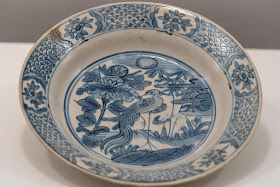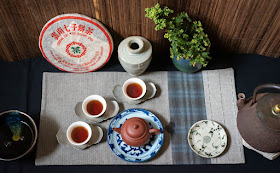 |
| 2003 private cake vs 1999 Menghai 7542 |
I live in Taiwan and have never traveled to Yunnan. So it's probably a surprise to see that I have listed the
Puerh category on the very top of all the teas I am selecting on
www.tea-masters.com. There are many reasons for this choice. Puerh is the most concentrated and powerful tea in the world. It's one of the rare tea tree that survives on its own in the wild. It's also one of the rare teas that ages extremely well. And Taiwan was one of the first place that recognized the importance and quality of this amazing tea (in the late 1980s-early 1990s). At that time, China was still very poor and exported all the best teas it produced. The best places to find aged puerh have long been Hong Kong and Taiwan. That's why my selection focuses mostly on aged puerhs. These teas are amazing, but increasingly expensive. However, in my selection, there are 2 very good bargains I would like to (re)introduce:
 |
| 2003 private cake vs 1999 Menghai 7542 |
1. Left: the
2003 small private factory raw puerh cake. 59.95 USD
In 2003, the puerh market wasn't regulated and the easiest way to sell puerh for new private factories was to use the same wrapping and packaging as in the past. On the neifei, it is mentioned Menghai Factory, but this isn't the case. From the slighthly lighter color of the buds, we can see that this cake is slightly younger as the one on the right.
2. Right: the
1999 Menghai 7542 raw puerh cake commissioned by the CNNP. 449 USD
This cake was commissioned by the CNNP and made by Menghai Tea Factory. That's why the neifei states CNNP. (During the communist/monopoly era, 1950-2000, the CNNP owned all the tea factories but there was no factory named CNNP). But there is no real doubt that the CNNP asked the cake expert, Menghai Tea Factory, to produce this cake. The quality of the leaves and several other details point in the same direction. But it's in part because it's not written Menghai that its price is actually very attractive compared to other 7542 cakes on the market. And also because I could purchase it in Taiwan in 2014 from someone owned the cakes for a long time.
 |
| 2003 private cake vs 1999 Menghai 7542 |

1. The
2003 small private factory raw puerh cake.
This cake is easy to flake. It's also available in a sample size of 25 gr (6.95 USD). The main difference with the 1999 cake is the leaves. We see much fewer buds. And most of these leaves are plantation puerh. This isn't so obvious when you look at the cakes.
The best way to brew this puerh is with a normal to generous amount of leaves, an Yixing zisha teapot (not a zhuni), a slow pour and short brewing times.
The brew is dark brown, but not black. It has a good transparency and color. The scent is what's best with this puerh. It comes very close to an aged 8582. These darker and heavier seem older, because this puerh had a more humid storage than the 7542. But it's not a ripe, cooked puerh. For this, the brew isn't dark enough and the wet leaves are not cooked (see below the last pic of this tea).
For a detailed review of this tea, I recommend reading
MattCha's blog post. Its woody scents and clean mouthfeel are a very good introduction to the world of aged puerh and a good choice for such an everyday tea.
The brew is getting a lighter hue at the end. And we can see that the leaves are not burned in the manner of cooked puerh. That's why this tea retains some coolness and freshness. In conclusion, this is the cheapest puerh of my selection and one of the Best Buy!
The other Best Buy puerh is the
1999 Menghai 7542 raw puerh cake commissioned by the CNNP.
This tea is also available in sample size so that you can taste it and see how you like it before purchasing a whole cake (29 USD for 20 gr).
The 7542 Menghai Factory cake is the successor of the Luyin, green mark puerh. Many say that the red mark is the best cake of that era, as it predates the green mark and is more expensive. However, according to Teaparker (who has often tasted both), the Luyin/green mark is superior. The green mark uses smaller leaves and more buds than the red mark and this adds finesse to its taste and aftertaste.
Also, thanks to the fact that the 7542 cake was pressed every year, it's possible to forecast its evolution in terms of aging and pricing. See how my
early 1990s Luyin costs 1500 USD! In China, So, this 1999 cake has just turned 20 years old and is bound to see its price increase in a couple of months...
I'm using the same teapot,
ivory porcelain cups, water and kettle for this tea, so that I can compare them. However, I'm not brewing this puerh exactly the same way. Thanks to its high concentration of aromas in the buds, I'm using fewer leaves and therefore I brew them a little bit longer.
The brew has a rich brown color and a complete lack of turbidity. It shines. And the result is delicious, because it combines the fresh energy of raw puerh, the woody and incense scents of aged puerh and the smooth refinement of aging. It coats the whole mouth in a clean and luscious way and it resonates for a long, long time. This takes the aged puerh to another level, but it's interesting how close both scents come. It's just that the youth and energy of this 20 years old puerh is much better preserved.
The explanation comes from the wet leaves. Below, we can see that the 1999 puerh (right) have a lighter color. This indicates a drier storage. (The other reason for the concentration was the higher proportion of buds). At slightly more than 1 USD per gram, a price often exceeded by good quality new puerhs,
this 20 year old cake is really another Best Buy in my selection!
 |
| 2003 private cake vs 1999 Menghai 7542 |
Note: if you're looking for a third puerh Best Buy, I recommend the
2003 wild Yiwu cake. This is a puerh I've selected at the start of my tea adventures, 15 years ago! I've stored it in my Taipei apartment ever since. At 495 USD per cake (500 gr), its price per gram is cheaper than the 1999 '7542' and cheaper than many new wild raw puerhs! And it has already been very well aged in Taiwan's climate!











































